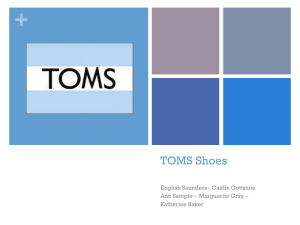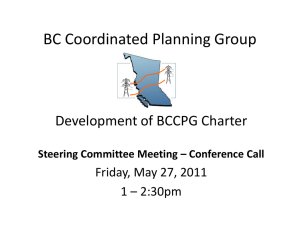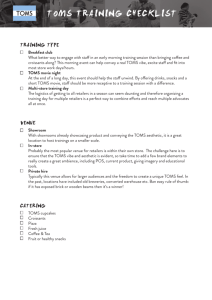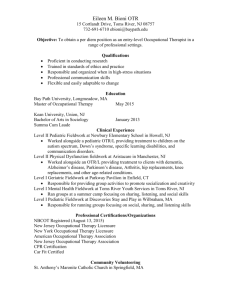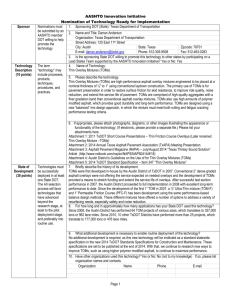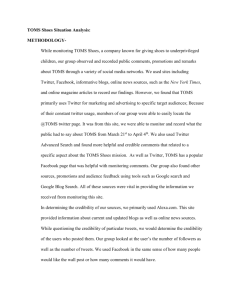04-03-2013 `Corporate Social Responsibility: How does the “One for
advertisement
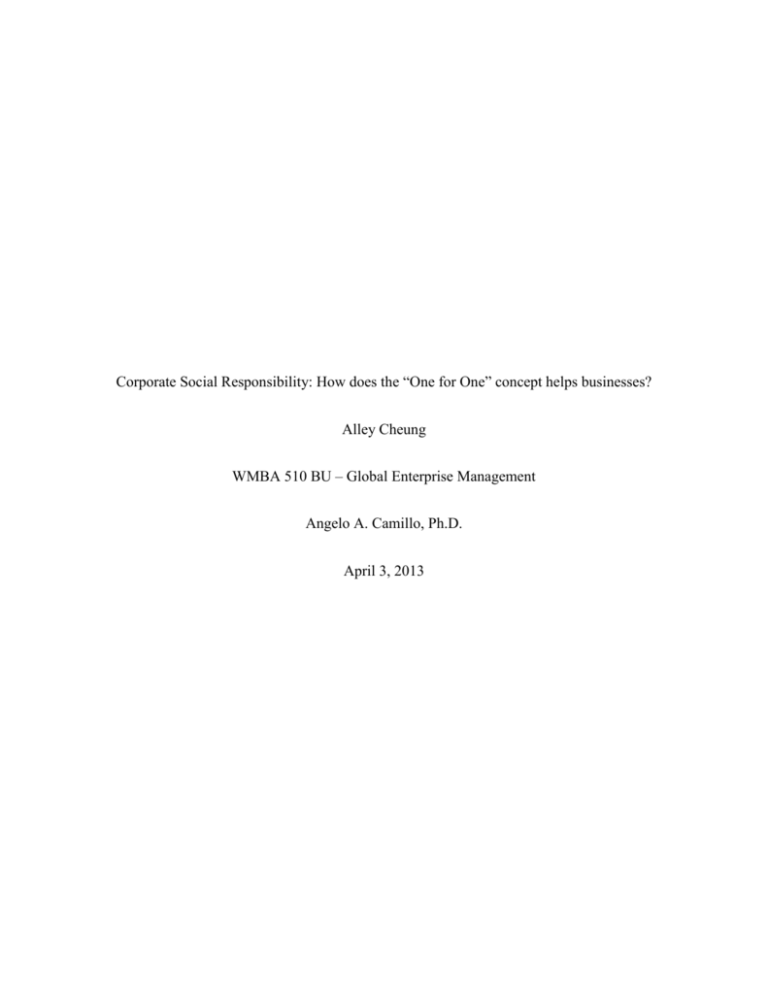
Corporate Social Responsibility: How does the “One for One” concept helps businesses? Alley Cheung WMBA 510 BU – Global Enterprise Management Angelo A. Camillo, Ph.D. April 3, 2013 Corporate Social Responsibility: How Does the “One for One” Concept Helps Businesses? 2 Part I – Introduction to corporate social responsibility Corporate social responsibility is “the duty of a corporation to create wealth in ways that avoid harm, protect, or enhance societal assets” (Steiner & Steiner, 2012, p.123). The fundamental idea is that corporations are responsible to go beyond lawful execution as they voluntarily take actions to meet their obligations to society in addition to responding only to market forces or Laws and regulations (Steiner & Steiner, 2012). There are four ideal types of corporate social responsibility described in the book Corporate Policy, Values and Social Responsibility(1985) by Anthony F. Buono and Larry Nichols, that: “1. Social responsibility refers to corporate behavior which is justified in terms of rational self-interest and the direct fulfillment of stockholder interests. 2. Social responsibility refers to corporate behavior which is justified in terms of moral duty and the direct fulfillment of stockholder interests. 3. Social responsibility refers to corporate behavior which is justified in terms of rational self-interest and the direct fulfillment of stakeholder interests. 4. Social responsibility refers to corporate behavior which is justified in terms of moral duty and the direct fulfillment of stakeholder interests” (Buono, 1985, pp.73). According to Buono, the key to effective management is to find a balance among the needs of the stakeholders of the company and the society (Buono, 1985). To be more specific, the social Corporate Social Responsibility: How Does the “One for One” Concept Helps Businesses? 3 responsibility of a business is to maximize its profits and at the same time have a “‘social conscience’ and takes seriously its responsibilities for providing employment, eliminating discrimination, avoiding pollution, and whatever else may be the catchwords of the contemporary crop of reformers” (Snoeyenbos, 2001, pp. 72). In Dan Keeler’s article “Spread the Love and Make It Pay”, he shares that “A company is socially responsible if it takes seriously its obligations to all of its stakeholders. It is not about whether a company sponsors local events or environmental programs, or has a foundation that gives money to charitable causes. It is about developing a reputation of integrity so there is trust with employees, investors, customers, suppliers, and their communities” (Keeler, 2002). PART II – The concept of One-for-One movement It has been over a decade since the concept of social responsibility has been introduced to the business world. However, the possibility for companies to do well and at the same time do good to the society is always doubted. Rosabeth Moss Kanter, in the article “How to Do Well and Do Good”, states that “social good and profitability are among the criteria by which companies make choices. In reality, any company is better off creating both bottom-line and societal benefits – and creating synergies between them” (Kanter, 2010, pp. 12). Kanter also comments that “if a company can integrate the benefits that it offers society more closely into its existing business, that integration can be very sensible and beneficial for the business” (pp. 12). Therefore, a company that performs well in its business should also be socially responsible to the community. While leaders of most business corporations care the most about how much profits they make for the firms, and many of them try to maximize profits by cutting down expenses. Those Corporate Social Responsibility: How Does the “One for One” Concept Helps Businesses? 4 expenses may include employee benefits, office expenses, capital expenses, and mass layoff. “Others, however, believe that an important part of their business success is linked to the powerful and positive impact that they have on their communities” (Michelli, 2007, pp.152). There are different ways for a business to be socially responsible; making cash contribution is the least motivating one that cannot promote employees’ engagement to the community. The “One for One Movement” started by TOMS shoes is gaining more attention from the society recently. The original idea is that TOMS will give a pair of new shoes to a child in need with every pair of TOMS shoes sold (TOMS, 2012). This is what meant by “One for One”. The company learned that shoes are essential to children in developing countries to protect them from disease and soil-based infection, and they also give the children a chance to go to school as it is a requirement for them to attend school with proper uniform and proper shoes (TOMS, 2012). Based on this knowledge, TOMS came up with an idea about the one-for-one business model, which has been proven to help their sales, while at the same time paying back to the society with what they are good at. This movement has also changed the commonly accepted model of companies being socially responsible means money donation or volunteering in community services. TOMS’ contribution to the one-for-one business model is just a beginning of the movement. Giving out shoes can only help the children to solve their immediate problem, which is considered to be treating the symptom without touching the deeper part of treating the cause (Jannuzzi, 2013). We all know that poverty is the problem of most developing countries, and we need to help them to get out of the poverty trap by safeguarding them against the coincidence of depending on foreign aid. Instead, we should equip them with the abilities to make a living on their own. This goal can be achieved by providing job opportunities in developing countries with Corporate Social Responsibility: How Does the “One for One” Concept Helps Businesses? 5 proper trainings. Taking VisionSpring as an example, in addition to donate eyeglasses to people in need, they also help to train people in developing to provide eye exams (SIBM, 2013). The impact is they not only create job opportunities to the community, but also give them the knowledge to identify whether a person needs glasses or not. Moreover, Starbucks is making a difference among all other companies in the industry, too. Recently, Starbucks bought a coffee farm in Costa Rica to plant its own ethically sourced coffee (Booton, 2013), as “small coffee farmers get a living wage for their work, and that no child, forced, or slave labor was used in the production of that coffee” (Kloer, 2011).. Knowing that Starbucks will hire the local Costa Ricans to work in the coffee farm, Starbucks is demonstrating a business aiming to treat the cause, i.e. job creation in developing country. Last but not least, the further step of the one-for-one concept is to help restoring health of the societies, with the “buy one, fund one” idea (Jannuzzi, 2013). Companies can fund to help people in developing countries to start their own business by investing profits into micro-loans. At this point, people being helped can become independent without the need of foreign aid. Moreover, when the people pay back the loans with interests, the company will have more funds to invest into another micro-finance. As a result, more and more people can benefit from the micro-finance. And if the people who got help from micro-loans follow the same pattern and help someone else to start a business, the whole situation of a developing country can be completely changed. PART III – Conclusion Corporate Social Responsibility: How Does the “One for One” Concept Helps Businesses? 6 For companies which try to do good and make a long-term influence to the industry, or to the world, Melissa Kushner, the founder and Executive Director of a nonprofit organization Goods for Good, has summarized her most important lessons learned as follow: “1. The good alone is not good enough; it must be the means to a bigger end. 2. Leverage the good. 3. Work with local institutions, and 4. Use the good to support local initiatives, not replace them.” (Kushner, 2013). A company can be better described as socially responsible when it can start with an idea to do something influential enough to encourage other to participate in the movement. Only with such intention, they can do big by starting small; eventually change the world’s business models and the living standard of people in long run. A good business can increase the public awareness of being socially responsible, and the ripple effect can create an unimaginable long-term positive change to the world. Corporate Social Responsibility: How Does the “One for One” Concept Helps Businesses? 7 References Booton, J. (2013). Starbucks buys first Costa Rican farm to develop new coffee blends. FOX Business. Retrieved from http://www.foxbusiness.com/industries/2013/03/19/starbucksbuys-first-costa-rican-farm-to-develop-new-coffee-blends/. Buono, A. F., & Nichols, L. T. (1985). Corporate policy, values, and social responsibility. New York: Praeger. Jannuzzi, D. (2013). Buy one, give what? Examining the social impact of the One for OneTM movement. Retrieved from http://www.brandcentered.com/culturalstandpoints/2012/05/buy-one-give-whatexamining-the-social-impact-of-the-one-for-one-movement/ Keeler, D. (2002, May). Spread the love and make it pay. Global Finance, 16(5), 20-25. Kanter, R. (2010). How to Do Well and Do Good. MIT Sloan Management Review, 52(1), 1215. Kloer, A. (2011, January 9). Starbucks ignores customer demands for more fair trade coffee. Retrieved from http://www.organicconsumers.org/articles/article_22327.cfm Kushner, M. (2013). How TOMS and buy-one-give-one really help buy-one-give-one businesses like TOMS can make real difference. Retrieved from http://www.good.is/posts/buy-onegive-one-businesses-like-toms-can-make-real-difference/ Michelli, J. A. (2007). The Starbucks experience: 5 principles for turning ordinary into extraordinary. New York: McGraw-Hill. SIBM (2013). VisionSpring – Bringing clear vision to the worlds poor. Retrieved from http://sibm.co/2013/03/17/visionspring-bringing-clear-vision-to-the-worlds-poor/ Corporate Social Responsibility: How Does the “One for One” Concept Helps Businesses? 8 Snoeyenbos, M., Almeder, R. F., & Humber, J. M. (2001). Business ethics. Amherst, N.Y: Prometheus Books. Steiner J. F. & Steiner G. A. (2012). Business, government, and society: a managerial perspective. New York, NY: McGraw-Hill TOMS (2012). TOMS giving report. Retrieved from http://www.toms.com/media/docs/2869/TOMS_Giving-Report_2012.pdf
